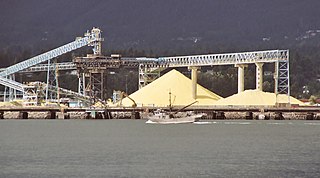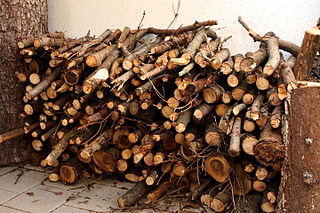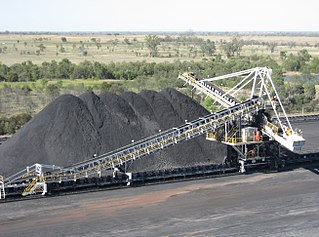
A conveyor belt is the carrying medium of a belt conveyor system. A belt conveyor system is one of many types of conveyor systems. A belt conveyor system consists of two or more pulleys, with a closed loop of carrying medium—the conveyor belt—that rotates about them. One or both of the pulleys are powered, moving the belt and the material on the belt forward. The powered pulley is called the drive pulley while the unpowered pulley is called the idler pulley. There are two main industrial classes of belt conveyors; Those in general material handling such as those moving boxes along inside a factory and bulk material handling such as those used to transport large volumes of resources and agricultural materials, such as grain, salt, coal, ore, sand, overburden and more.

Firewood is any wooden material that is gathered and used for fuel. Generally, firewood is not heavily processed and is in some sort of recognizable log or branch form, compared to other forms of wood fuel like pellets. Firewood can be seasoned and heat treated (dry) or unseasoned (fresh/wet). It is generally classified as either hardwood or softwood.

A reclaimer is a large machine used in bulk material handling applications. A reclaimer's function is to recover bulk material such as ores and cereals from a stockpile. A stacker is used to stack the material.

A stacker is a large machine used in bulk material handling. Its function is to pile bulk material such as limestone, ores, coal and cereals onto a stockpile. A reclaimer can be used to recover the material.

Bulk material handling is an engineering field that is centered on the design of equipment used for the handling of dry materials. Bulk materials are those dry materials which are powdery, granular or lumpy in nature, and are stored in heaps. Examples of bulk materials are minerals, ores, coal, cereals, woodchips, sand, gravel, clay, cement, ash, salt, chemicals, grain, sugar, flour and stone in loose bulk form. It can also relate to the handling of mixed wastes. Bulk material handling is an essential part of all industries that process bulk ingredients, including: food, beverage, confectionery, pet food, animal feed, tobacco, chemical, agricultural, polymer, plastic, rubber, ceramic, electronics, metals, minerals, paint, paper, textiles and more.

A bucket-wheel excavator (BWE) is a large heavy equipment machine used in surface mining.

Cerrejón is a large open-pit coal mine in Northern Colombia owned by Glencore. At Cerrejón, low-ash, low-sulphur bituminous coal from the Cerrejón Formation is excavated. At over 690 square kilometres (270 sq mi) the mine is one of the largest of its type, the largest in Latin America and the tenth biggest in the world. Cerrejón is divided into three sections, North Zone, Central Zone and South Zone. Total proven reserves are estimated at 503 megatonnes. In 2016, the mine produced 32,683,315 tonnes.

A silo is a structure for storing bulk materials. Silos are used in agriculture to store fermented feed known as silage, not to be confused with a grain bin, which is used to store grains. Silos are commonly used for bulk storage of grain, coal, cement, carbon black, woodchips, food products and sawdust. Three types of silos are in widespread use today: tower silos, bunker silos, and bag silos.

A landship is a large land vehicle that travels exclusively on land. Its name is meant to distinguish it from vehicles that travel through other mediums such as conventional ships, airships, and spaceships.

A coal preparation plant is a facility that washes coal of soil and rock, crushes it into graded sized chunks (sorting), stockpiles grades preparing it for transport to market, and more often than not, also loads coal into rail cars, barges, or ships.

Material handling equipment (MHE) is mechanical equipment used for the movement, storage, control, and protection of materials, goods and products throughout the process of manufacturing, distribution, consumption, and disposal. The different types of equipment can be classified into four major categories: transport equipment, positioning equipment, unit load formation equipment, and storage equipment.

A conveyor system is a common piece of mechanical handling equipment that moves materials from one location to another. Conveyors are especially useful in applications involving the transport of heavy or bulky materials. Conveyor systems allow quick and efficient transport for a wide variety of materials, which make them very popular in the material handling and packaging industries. They also have popular consumer applications, as they are often found in supermarkets and airports, constituting the final leg of item/ bag delivery to customers. Many kinds of conveying systems are available and are used according to the various needs of different industries. There are chain conveyors as well. Chain conveyors consist of enclosed tracks, I-Beam, towline, power & free, and hand pushed trolleys.

A concrete plant, also known as a batch plant or batching plant or a concrete batching plant, is equipment that combines various ingredients to form concrete. Some of these inputs include water, air, admixtures, sand, aggregate, fly ash, silica fume, slag, and cement. A concrete plant can have a variety of parts and accessories, including: mixers, cement batchers, aggregate batchers, conveyors, radial stackers, aggregate bins, cement bins, heaters, chillers, cement silos, batch plant controls, and dust collectors.
Heyl & Patterson Inc. is an American specialist engineering company, founded in 1887 and based in Pittsburgh, Pennsylvania.
The term bulk material analyzer is the generic noun for that device which fits around a conveyor belt and conducts real-time elemental analysis of the material on the belt. Other names often found for such a device include belt analyzer, crossbelt analyzer and elemental analyzer. This product first found popularity in the cement industry during the 1990s, and today most new cement plants include at least one analyzer, if not two.

Spreaders in mining are heavy equipment used in surface mining and mechanical engineering/civil engineering. The primary function of a spreader is to act as a continuous spreading machine in large-scale open pit mining operations.

TAKRAF India Private Limited is a wholly owned subsidiary of TAKRAF GmbH. As with its parent company, TAKRAF India provides equipment, systems and services to the mining and associated industries through the TAKRAF and DELKOR brands.

Coal homogenization refers to the process of mixing coal to reduce the variance of the product supplied. This homogenization process is performed during the coal stockpiling operation. Although the terms blending and homogenization are often used interchangeably, there are differences, as the definitions show. The most notable difference is that blending refers to stacking coal from different sources together on one stockpile. The reclaimed heap would then typically have a weighted average output quality of the input sources. In contrast, homogenization focuses on reducing the variance of only one source. A blending operation will cause some homogenization.

NIAflow is simulation software for mineral processing plants. Based on a flowsheet interface, it calculates the material flow through a variety of processing machinery.
Mormugao Port Authority (MPA) is a port on the western coast of India, in the coastal state of Goa. Commissioned in 1885 on the site of a natural harbour, it is one of India's oldest ports. The port employs around 2,600 employees and has about 4,000 pensioners.

















